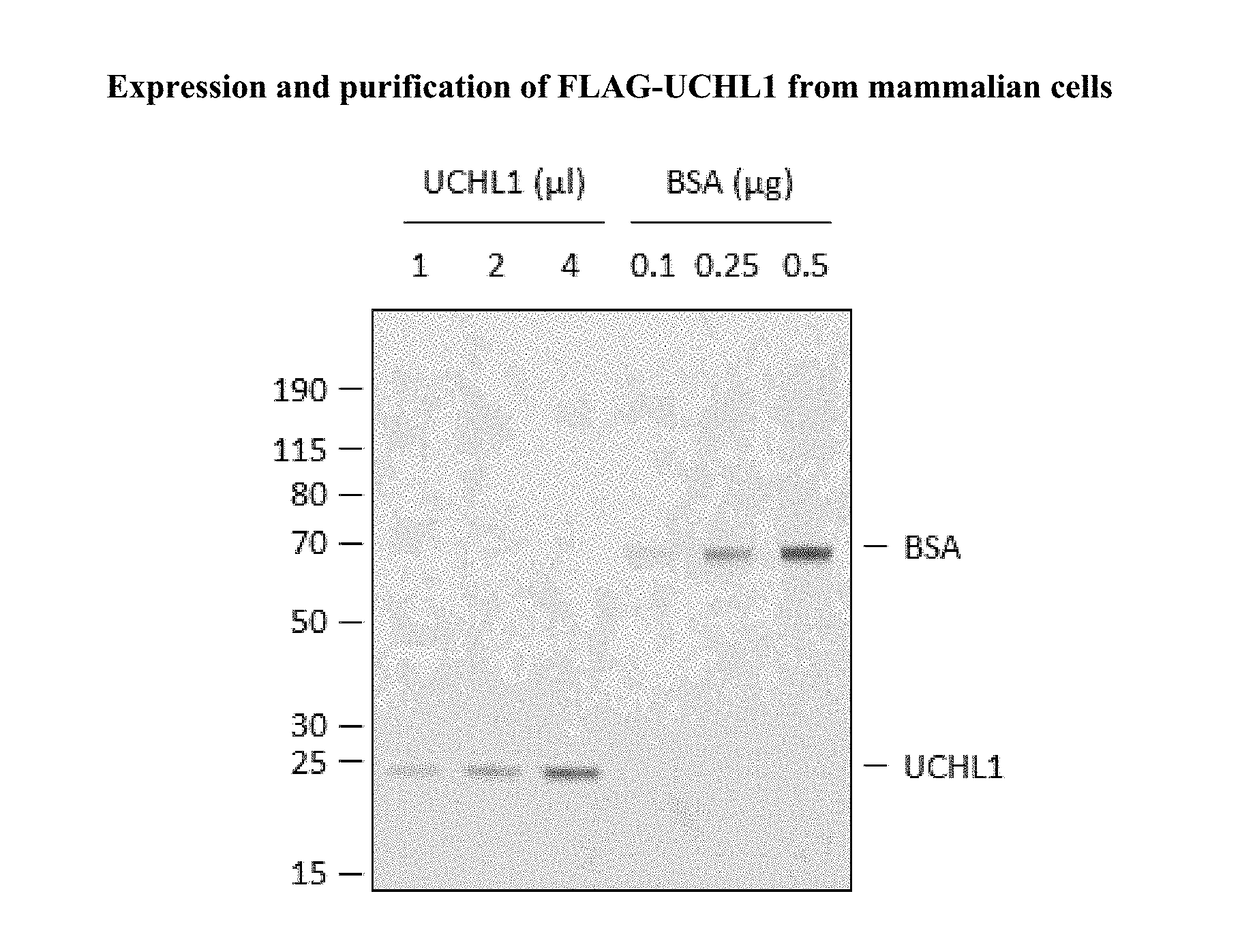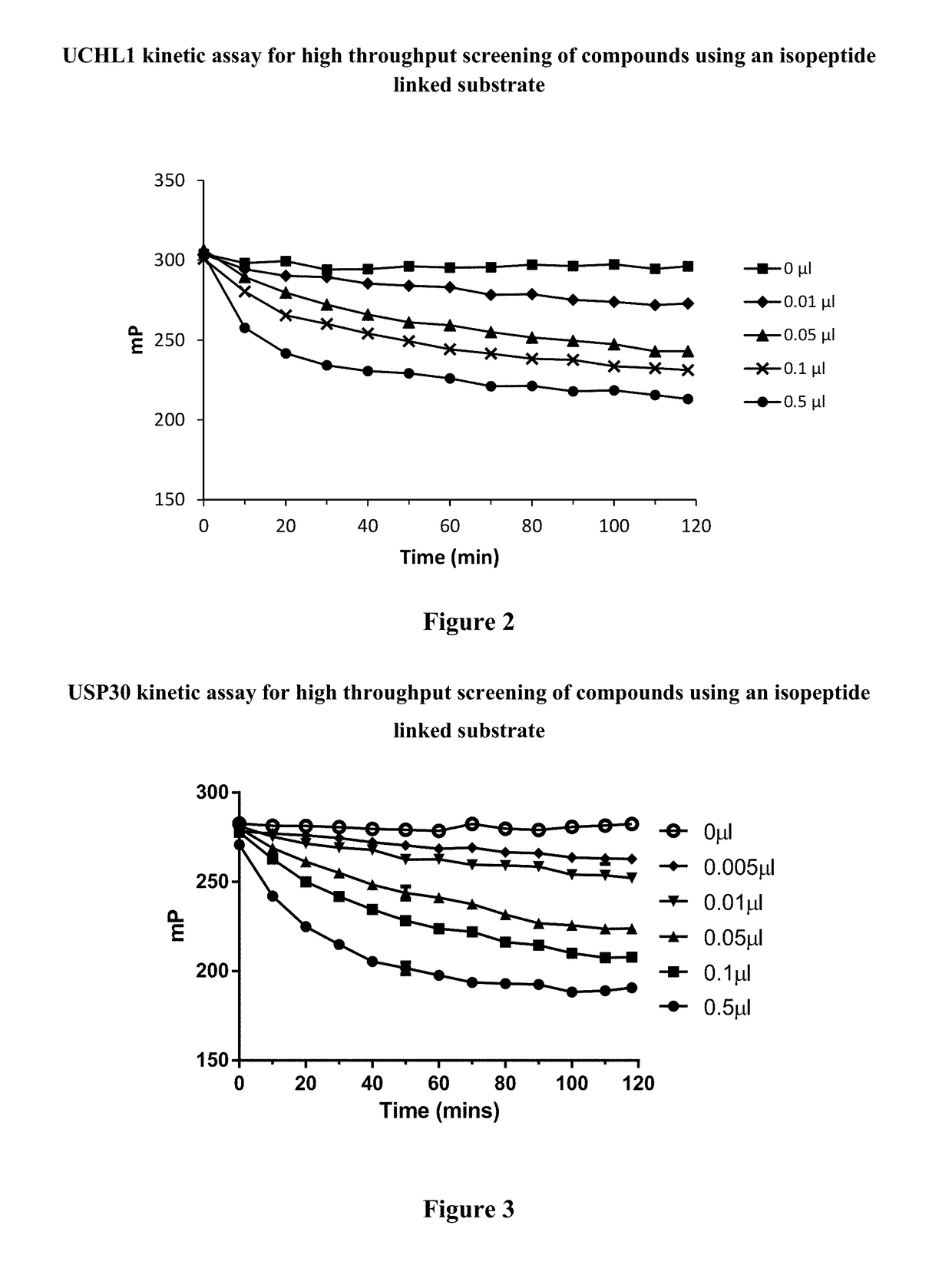Cyanopyrrolidines as dub inhibitors for the treatment of cancer
- Summary
- Abstract
- Description
- Claims
- Application Information
AI Technical Summary
Benefits of technology
Problems solved by technology
Method used
Image
Examples
example 1
(S)-2-(4-Ethoxyindoline-1-carbonyl)pyrrolidine-1-carbonitrile
[0410](Prepared According to Scheme 1)
[0411]Step a. To a solution of BOC-L-proline (0.71 g, 3.30 mmol) in DMF (12 ml) were added HATU (1.25 g, 3.30 mmol) and DIPEA (0.71 g, 5.50 mmol) at 0° C. The reaction mixture was stirred at 0° C. for 15 min. 4-Ethoxyindoline (CAS Number 220657-56-7) (0.45 g, 2.70 mmol) was dissolved in DMF (2 ml) and added dropwise to the reaction mixture at 0° C. The reaction mixture was stirred at rt for 30 min. The resulting reaction mixture was poured into water (50 ml) and extracted with EtOAc (5×50 ml). The combined organic phase was collected, dried over Na2SO4, filtered and concentrated under reduced pressure yielding tert-butyl (S)-2-(4-ethoxyindoline-1-carbonyl)pyrrolidine-1-carboxylate (0.53 g, 1.47 mmol). This material was used directly for the next step without further purification. LCMS: Method C, 2.485 min, MS: ES+ 361.29.
[0412]Step b. To a solution of tert-butyl (S)-2-(4-ethoxyindoline...
example 6
(S)-2-(4-Phenylindoline-1-carbonyl)pyrrolidine-1-carbonitrile
[0415](Prepared According to Scheme 2)
[0416]Step a. A solution of 4-bromo-1H-indole (CAS Number 52488-36-5) (0.5 g, 2.55 mmol) and phenylboronic acid (0.310 g, 2.55 mmol) in toluene (5 ml), ethanol (2.5 ml) and water (1.2 ml) was prepared in a glass vial. K2CO3 (1.4 g, 10.20 mmol) was added to the reaction mixture at rt. The reaction mixture was degassed for 10 min. Pd(PPh3)4 (0.147 g, 0.13 mmol) was added to the reaction mixture at rt. The glass vial was sealed and subjected to heating at 100° C. (external temperature) for 2 h. The resulting reaction mixture was poured into water (50 ml) and extracted with EtOAc (3×50 ml). The combined organic phase was collected, dried over Na2SO4, filtered and concentrated under reduced pressure. The resulting residue was purified by flash chromatography (15% EtOAc in hexane) yielding 4-phenyl-1H-indole (0.430 g, 2.22 mmol). LCMS: Method C, 2.355 min, MS: ES+ 194.19.
[0417]Step b. To a s...
example 19
(S)-2-(4-(5-(Trifluoromethyl)-1H-pyrazol-4-yl)indoline-1-carbonyl)pyrrolidine-1-carbonitrile
[0424](Prepared According to Scheme 3)
[0425]Step a. Tert-butyl (S)-2-(4-bromoindoline-1-carbonyl)pyrrolidine-1-carboxylate was prepared according to the method described for Intermediate B.
[0426]Step b. A solution of Intermediate B (1.0 g, 2.53 mmol), 4-(4,4,5,5-tetramethyl-1,3,2-dioxaborolan-2-yl)-5-(trifluoromethyl)-1H-pyrazole (CAS Number 1218790-40-9) (0.66 g, 2.53 mmol) and NaHCO3 (0.43 g, 5.06 mmol) in DMF:water (9:1, 15 ml) was stirred at rt in a microwave tube. The reaction mixture and degassed for 15 min. Pd(dppf)Cl2 (0.19 g, 0.25 mmol) was added and the reaction mixture was heated at 110° C. for 1.5 h in microwave. The resulting reaction mixture was combined with 14 other batches prepared on the same scale by an identical method, then poured into water (500 ml). The resulting mixture was extracted with EtOAc (3×250 ml). The combined organic phase was washed with brine solution (200 ...
PUM
| Property | Measurement | Unit |
|---|---|---|
| Temperature | aaaaa | aaaaa |
| Temperature | aaaaa | aaaaa |
| Molar density | aaaaa | aaaaa |
Abstract
Description
Claims
Application Information
 Login to View More
Login to View More - R&D
- Intellectual Property
- Life Sciences
- Materials
- Tech Scout
- Unparalleled Data Quality
- Higher Quality Content
- 60% Fewer Hallucinations
Browse by: Latest US Patents, China's latest patents, Technical Efficacy Thesaurus, Application Domain, Technology Topic, Popular Technical Reports.
© 2025 PatSnap. All rights reserved.Legal|Privacy policy|Modern Slavery Act Transparency Statement|Sitemap|About US| Contact US: help@patsnap.com



